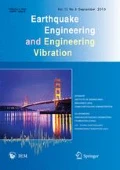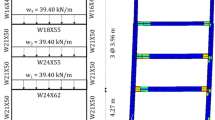Abstract
Evaluation of structural performance under seismic excitations from low intensity to high intensity is essential to verify the seismic resistant capacity of a structure, and usually carried out by the incremental dynamic analysis (IDA) method or pushover method. The recently developed endurance time (ET) method is another method that uses dynamic pushover excitations, i.e., endurance time acceleration function, to obtain results similar to those obtained by IDA or pushover methods with low computational cost and acceptable accuracy. This study proposes an improvement on the ET method by considering more restrictions for both the elastic and inelastic response spectra in the generation procedure, and by specifying a target duration. Four reinforced concrete frame structures with 4, 8, 12, and 16 stories are adopted to verify the accuracy of the improved method. Comparison of the results obtained by the proposed method, the ET method and the IDA method shows that the improved method has a higher accuracy than the ET method. For evaluation of structural responses under specific ground motion intensity, which is typically required in seismic design codes, the results obtained by the proposed method are compared with five commonly used ground motion selection methods, and shows the proposed method provides acceptable accuracy for engineering applications.
Similar content being viewed by others
References
Alembagheri M and Estekanchi HE (2011), “Seismic Assessment of Unanchored Steel Storage Tanks by Endurance Time Method,” Earthquake Engineering and Engineering Vibration, 10(4): 591–604.
Ardebili MAH, Mirzabozorg H and Kianoush R (2012), “A Study on Nonlinear Behavior and Seismic Damage Assessment of Concrete Arch Dam-Reservoir-Foundation System using Endurance Time Analysis,” International Journal of Optimization in Civil Engineering, 2(4): 573–606.
ASCE Standard ASCE/SEI 7–10 (2010), Minimum Design Loads for Buildings and Other Structures, American Society of Civil Engineers (ASCE), Reston, VA, USA.
Baker JW (2011), “Conditional Mean Spectrum: Tool for Ground-Motion Selection,” Journal of Structural Engineering, 137(3): 322–331.
Bai JL and Ou JP (2016), “Seismic Performance Evaluation of Reinforced Concrete Frame Structures using Endurance Time Method,” Engineering Mechanics, 33(10): 86–96. (in Chinese)
Basim MC and Estekanchi HE (2015), “Application of Endurance Time Method in Performance-Based Optimum Design of Structures,” Structural Safety, 56: 52–67.
Bu Zhanyu, Guo Jian, Zheng Rongyue, Song Jianwei and Lee GC (2016), “Cyclic Performance and Simplified Pushover Analyses of Precast Segmental Concrete Bridge Columns with Circular Section,” Earthquake Engineering and Engineering Vibration, 15(2): 297–312.
Chiniforush AA, Estekanchi H and Dolatshahi KM (2017), “Application of Endurance Time Analysis in Seismic Evaluation of An Unreinforced Masonry Monument,” Journal of Earthquake Engineering, 21(2): 181–202.
Chopra AK (2001), Dynamic of Structures: Theory and Applications to Earthquake Engineering, Prentice-Hall, Inc.
Chopra AK and Goel RK (2002), “A Modal Pushover Analysis Procedure for Estimating Seismic Demands for Buildings,” Earthquake Engineering and Structural Dynamics, 31(3): 561–582.
Code for seismic design of buildings (GB50011 2010) (2010), Ministry of Housing and Urban-Rural Development of P. R. China, China Architecture and Building Press, Beijing, China.
Estekanchi HE, Arjomandi K and Vafai A (2008), “Estimating Structural Damage of Steel Moment Frames by Endurance Time Method,” Journal of Constructional Steel Research, 64(2): 145–155.
Estekanchi HE, Riahi HT and Vafai A (2011), “Application of Endurance Time Method in Seismic Assessment of Steel Frames,” Engineering Structures, 33(9): 2535–2546.
Estekanchi HE, Vafai A and Sadeghazar M (2004), “Endurance Time Method for Seismic Analysis and Design of Structures,” Scientia Iranica, 11(4): 361–370.
Estekanchi HE, Valamanesh V and Vafai A (2007), “Application of Endurance Time Method in Linear Seismic Analysis,” Engineering Structures, 29(10): 2551–2562.
Eurocode 8 (2004), Design of Structures for Earthquake Resistance. Part 1: General Rules, Seismic Action and Rules for Buildings, European Committee for Standardization, Brussels, Belgium.
Fiore A, Spagnoletti G and Greco R (2016), “On the Prediction of Shear Brittle Collapse Mechanisms due to the Infill-Frame Interaction in RC Buildings under Pushover Analysis,” Engineering Structures, 121: 147–159.
Foyouzat MA and Estekanchi HE (2016), “Application of Rigid-Perfectly Plastic Spectra in Improved Seismic Response Assessment by Endurance Time Method,” Engineering Structures, 111: 24–35.
Gelfi P (2017), SIMQKE_GR (Version 2.7), https://doi.org/gelfi.unibs.it/software/simqke/simqke_gr.htm.
Gencturk B, Hossain K and Lahourpour S (2016), “Life Cycle Sustainability Assessment of RC Buildings in Seismic Regions,” Engineering Structures, 110: 347–362.
Günay S and Mosalam KM (2013), “PEER Performance-Based Earthquake Engineering Methodology, Revisited,” Journal of Earthquake Engineering, 17(6): 829–858.
Hariri-Ardebili MA, Mirzabozorg H and Estekanchi HE (2014b), “Nonlinear Seismic Assessment of Arch Dams and Investigation of Joint Behavior using Endurance Time Analysis Method,” Arabian Journal for Science and Engineering, 39(5): 3599–3615.
Hariri-Ardebili MA, Mirzabozorg H and Kianoush R (2014c), “Comparative Study of Endurance Time and Time History Methods in Seismic Analysis of High Arch Dams,” International Journal of Civil Engineering, 12(2): 219–236.
Hariri-Ardebili MA and Saouma V (2015), “Quantitative Failure Metric for Gravity Gams,” Earthquake Engineering and Structural Dynamics, 44(3): 461–480.
Hariri-Ardebili MA, Sattar S and Estekanchi HE (2014a), “Performance-Based Seismic Assessment of Steel Frames using Endurance Time Analysis,” Engineering Structures, 69: 216–234.
Hariri-Ardebili MA, Zarringhalam Y, Estekanchi HE and Yahyai M (2013), “Nonlinear Seismic Assessment of Steel Moment Frames using Time-History, Incremental Dynamic, and Endurance Time Analysis Methods,” Scientia Iranica A, 20(3): 431–444.
Haselton C, Liel A, Deierlein G, Dean B and Chou J (2011), “Seismic Collapse Safety of Reinforced Concrete Buildings: I. Assessment of Ductile Moment Frames,” Journal of Structural Engineering, 137(4): 481–491.
IBC 2015 (2015), International Building Code 2015, International Code Council, Inc., Country Club Hills, IL, USA.
IDARC-2D (2010), Inelastic Damage Analysis of Reinforced Concrete Structures. Version 7.0, University at Buffalo, The state university of New York, https://doi.org/civil.eng.buffalo.edu/idarc2d50.
Jough FKG and Şensoy S (2016), “Prediction of Seismic Collapse Risk of Steel Moment Frame Mid-Rise Structures by Meta-Heuristic Algorithms,” Earthquake Engineering and Engineering Vibration, 15(4): 743–757.
Kalkan E and Chopra AK (2011), “Modal-Pushover Based Ground-Motion Scaling Procedure,” Journal of Structural Engineering, 138(3): 289–310.
Kalkan E and Kunnath SK (2006), “Adaptive Modal Combination Procedure for Nonlinear Static Analysis of Building Structures,” Journal of Structural Engineering, 132(11): 1721–1732.
Kaveh A and Mahdavi VR (2012), “Generation of Endurance Time Acceleration Functions using the Wavelet Transform,” International Journal of Optimization in Civil Engineering, 2(2): 203–219.
Li S, Zuo ZX, Zhai CH and Xie LL (2017), “Comparison of Static Pushover and Dynamic Analyses using RC Building Shaking Table Experiment,” Engineering Structures, 136: 430–440.
Liu Xiangyang (2017), “Research and Application on Structural Dynamic Analysis using Incremental Earthquake Excitation,” Master Thesis, Harbin Institute of Technology. (in Chinese)
Liu ZF, Atamturktur S and Juang CH (2013), “Performance Based Robust Design Optimization of Steel Moment Resisting Frames,” Journal of Constructional Steel Research, 89: 165–174.
Matlab (2017), https://doi.org/www.mathworks.com/products/matlab.html.
Maleki MJ and Estekanchi HE (2017), “Application of Damage Spectra as Seismic Intensity Measures in Endurance Time Method for Steel Moment-Resisting Frames,” Scientia Iranica A, 24(1): 53–64.
Mashayekhi M and Estekanchi HE (2013), “Investigation of Non-Linear Cycles’ Properties in Structures Subjected to Endurance Time Excitation Functions,” International Journal of Optimization in Civil Engineering, 3(2): 239–257.
Mirzaee A, Homayoon E and Estekanchi E (2015), “Performance-Based Seismic Retrofitting of Steel Frames by the Endurance Time Method,” Earthquake Spectra, 31(1): 383–402.
Mitropoulou CC, Lagaros ND and Papadrakakis (2011), “Life-Cycle Cost Assessment of Optimally Designed Reinforced Concrete Buildings under Seismic Actions,” Reliability Engineering and System Safety, 96(10): 1311–1331.
Nozari A and Estekanchi HE (2011), “Optimization of Endurance Time Acceleration Functions for Seismic Assessment of Structures,” International Journal of Optimization in Civil Engineering, 2(1): 257–277.
Panyakapo P (2014), “Cyclic Pushover Analysis Procedure to Estimate Seismic Demands for Buildings,” Engineering Structures, 66: 10–23.
Riahi HT, Amouzegar H and Falsafioun M (2015), “Seismic Collapse Assessment of Reinforced Concrete Moment Frames using Endurance Time Analysis,” The Structural Design of Tall and Special Buildings, 24(4): 300–315.
Riahi HT, Estekanchi HE and Boroujeni SS (2011), “Application of Endurance Time Method in Nonlinear Seismic Analysis of Steel Frames,” Procedia Engineering, 14: 3237–3244.
Riahi HT and Estekanchi HE (2010), “Seismic Assessment of Steel Frames with the Endurance Time Method,” Journal of Constructional Steel Research, 66(6): 780–792.
Riahi HT, Estekanchi HE and Vafai A (2009), “Endurance Time Method-Application in Nonlinear Seismic Analysis of Single Degree of Freedom Systems,” Journal of Applied Sciences, 9(10): 1817–1832.
Rahimi E and Estekanchi HE (2015), “Collapse Assessment of Steel Moment Frames using Endurance Time Method,” Earthquake Engineering and Engineering Vibration, 14(2): 347–360.
Shafei B, Zareian F and Lignos DG (2011), “A Simplified Method for Collapse Capacity Assessment of Moment-Resisting Frame and Shear Wall Structural Systems,” Engineering Structures, 33(4): 1107–1116.
Shirkhani A, Mualla IH, Shabakhty N and Mousavi SR (2015), “Behaviour of Steel Frames with Rotational Dampers by Endurance Time Method,” Journal of Constructional Steel Research, 107: 211–222.
Stafford PJ, Berrill JB and Pettinga JR (2009), “New Predictive Equations for Arias Intensity from Crustal Earthquakes in New Zealand,” Journal of Seismology, 13(1): 31–52.
Tavazo H, Estekanchi HE and Kaldi P (2012), “Endurance Time Method in the Linear Seismic Analysis of Shell Structures,” International Journal of Civil Engineering, 10(3): 169–178.
Valamanesh, Estekanchi HE and Vafai A (2010), “Characteristics of Second Generation Endurance Time Acceleration Functions,” Transaction A: Civil Engineering, 17(1): 53–61.
Vamvatsikos D and Cornell CA (2002), “Incremental Dynamic Analysis,” Earthquake Engineering and Structural Dynamics, 31(3): 491–514.
Xie FW (2016), “Study and Evaluation on Selecting and Scaling of Ground Motions,” Master Thesis, Harbin Institute of Technology. (in Chinese)
Yang L, Bai JL and Ou JP (2014), “Endurance Time Analysis of Seismic Response and Failure Process of Steel Frames Structures,” Journal of Disaster Prevention and Mitigation Engineering, 34(4): 416–421. (in Chinese)
Zacharenaki AE, Fragiadakis M and Papadrakakis M (2013), “Reliability-Based Optimum Seismic Design of Structures using Simplified Performance Estimation Methods,” Engineering Structures, 52: 707–717.
Zeinoddini M, Nikoo HM and Estekanchi H (2012), “Endurance Wave Analysis (EWA) and its Application for Assessment of Offshore Structures under Extreme Waves,” Applied Ocean Research, 37: 98–110.
Acknowledgement
This research project was supported by National Key R&D Program of China (No. 2016YFC0701500) and National Natural Science Foundation of China (No. 51578202). This financial support is greatly appreciated by the authors.
Author information
Authors and Affiliations
Corresponding author
Additional information
Supported by: National Key R&D Program of China under Grant No. 2016YFC0701500 and National Natural Science Foundation of China under Grant No. 51578202
Rights and permissions
About this article
Cite this article
Li, S., Liu, K., Liu, X. et al. Efficient structural seismic performance evaluation method using improved endurance time analysis. Earthq. Eng. Eng. Vib. 18, 795–809 (2019). https://doi.org/10.1007/s11803-019-0485-x
Received:
Accepted:
Published:
Issue Date:
DOI: https://doi.org/10.1007/s11803-019-0485-x



